-
 Bitcoin
Bitcoin $86,250.6982
1.63% -
 Ethereum
Ethereum $1,890.1026
-0.98% -
 Tether USDt
Tether USDt $1.0000
0.01% -
 XRP
XRP $2.1367
0.29% -
 BNB
BNB $603.5934
-0.76% -
 Solana
Solana $129.4201
2.45% -
 USDC
USDC $1.0000
0.00% -
 Dogecoin
Dogecoin $0.1724
0.45% -
 Cardano
Cardano $0.6839
0.62% -
 TRON
TRON $0.2381
0.57% -
 Toncoin
Toncoin $3.9840
-0.47% -
 Chainlink
Chainlink $13.8431
-2.30% -
 UNUS SED LEO
UNUS SED LEO $9.3956
0.41% -
 Stellar
Stellar $0.2705
-1.46% -
 Avalanche
Avalanche $19.2650
-0.80% -
 Sui
Sui $2.4309
0.03% -
 Shiba Inu
Shiba Inu $0.0...01260
-0.64% -
 Hedera
Hedera $0.1716
0.58% -
 Polkadot
Polkadot $4.1457
-0.42% -
 Litecoin
Litecoin $85.5964
0.72% -
 Bitcoin Cash
Bitcoin Cash $308.6728
-0.07% -
 MANTRA
MANTRA $6.3356
0.99% -
 Bitget Token
Bitget Token $4.5842
-0.52% -
 Dai
Dai $0.9997
-0.04% -
 Ethena USDe
Ethena USDe $0.9999
0.01% -
 Hyperliquid
Hyperliquid $13.7596
4.34% -
 Pi
Pi $0.6794
-3.81% -
 Monero
Monero $219.4683
1.07% -
 Uniswap
Uniswap $6.1878
-0.70% -
 Aptos
Aptos $5.3777
0.02%
Why do some blockchains need to adopt a layered architecture (such as Layer 2)?
Layer 2 solutions enhance blockchain scalability by offloading transactions from the main chain, improving speed and reducing fees while maintaining L1 security.
Mar 31, 2025 at 03:21 am
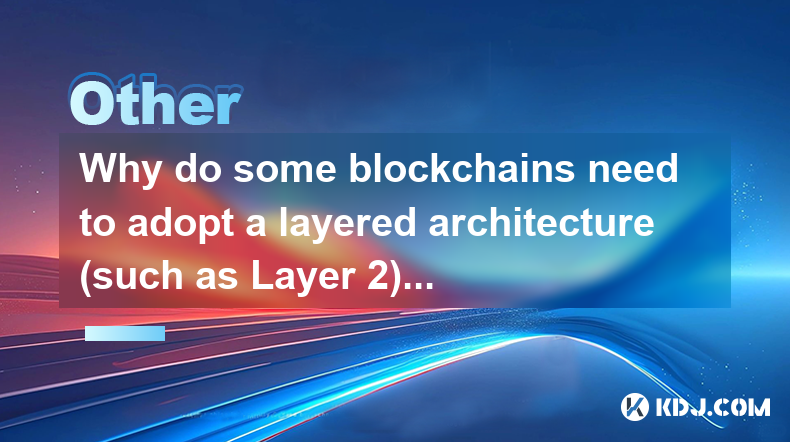
The Scalability Challenge in Blockchain Technology
Blockchains, at their core, are designed for security and decentralization. However, this inherent design often clashes with the need for high transaction throughput. Many blockchains struggle with scalability, meaning they can't handle a large volume of transactions efficiently. This limitation leads to slow transaction speeds and high fees, hindering widespread adoption. This is where layered architectures, primarily Layer 2 solutions, come into play.
Understanding the Limitations of Layer 1
Layer 1 (L1) refers to the base blockchain itself – the foundational protocol that governs consensus mechanisms, security, and transaction validation. L1 blockchains, like Bitcoin or Ethereum, are designed for security and decentralization above all else. This focus often comes at the cost of speed and transaction capacity. The inherent limitations of L1 blockchains, such as limited block sizes and slow transaction confirmation times, necessitate the development of Layer 2 solutions.
The Role of Layer 2 Solutions
Layer 2 (L2) solutions are built on top of the L1 blockchain. They are designed to handle a significant portion of the transaction processing, thereby offloading the burden from the main chain. This offloading improves scalability, reducing congestion and lowering transaction fees on the L1. Think of it like a highway system: L1 is the main highway, while L2s are the expressways that alleviate traffic congestion.
Common Layer 2 Scaling Solutions
Several types of Layer 2 solutions exist, each with its own approach to improving scalability:
State Channels: These allow multiple parties to transact off-chain, only submitting the final state to the L1. This significantly reduces the number of transactions on the main chain.
Rollups: These bundle multiple transactions together into a single transaction on the L1. This reduces the cost and improves efficiency. There are two main types: optimistic rollups and zk-Rollups. Optimistic rollups assume transactions are valid unless proven otherwise, while zk-Rollups use cryptographic proofs to verify transactions without revealing their details.
Plasma: This creates child blockchains that run alongside the main chain. Transactions occur on the child chains, and only disputes or final states are settled on the L1.
Sidechains: These are independent blockchains that run parallel to the main chain but are connected to it. They offer greater flexibility but may compromise security if not properly designed.
Why Choose a Layered Architecture?
The primary reason for adopting a layered architecture is to enhance scalability. By moving transactions off the main chain, Layer 2 solutions dramatically increase transaction throughput and reduce fees. This makes the blockchain more usable for a wider range of applications, including those requiring high transaction volumes, such as decentralized exchanges (DEXs) and decentralized finance (DeFi) protocols. Furthermore, Layer 2 solutions can improve privacy by keeping transaction details off the public L1 blockchain.
Security Considerations in Layered Architectures
While Layer 2 solutions offer significant benefits, security remains a crucial consideration. The security of a Layer 2 solution is ultimately dependent on the security of the underlying L1 blockchain. Any vulnerabilities in the L1 can potentially impact the security of L2 solutions built on top of it. Careful design and rigorous auditing are crucial to mitigate potential risks.
The Interplay Between Layer 1 and Layer 2
It's essential to understand that Layer 2 solutions are complementary to, not replacements for, Layer 1. The L1 provides the foundational security and decentralization, while the L2 handles the scalability challenges. The two layers work together to create a more robust and efficient blockchain ecosystem. The L1 remains the ultimate authority for settling disputes and ensuring the integrity of the entire system.
The Future of Layered Architectures
The development and adoption of Layer 2 solutions are crucial for the future of blockchain technology. As the demand for blockchain-based applications continues to grow, scalable solutions like Layer 2 will become increasingly important in ensuring the viability and widespread adoption of blockchain technology. Ongoing research and development are continuously improving the efficiency and security of these solutions.
Frequently Asked Questions
Q: What are the main benefits of using Layer 2 solutions?
A: The main benefits include increased transaction throughput, lower transaction fees, faster transaction speeds, and improved privacy.
Q: Are Layer 2 solutions secure?
A: The security of Layer 2 solutions depends on the security of the underlying Layer 1 blockchain. However, well-designed and audited Layer 2 solutions can offer a high degree of security.
Q: What are the different types of Layer 2 scaling solutions?
A: Common types include state channels, rollups (optimistic and zk-Rollups), Plasma, and sidechains. Each has its strengths and weaknesses.
Q: How do Layer 1 and Layer 2 interact?
A: Layer 2 solutions handle the bulk of transaction processing, offloading the burden from Layer 1. Layer 1 provides the ultimate security and settlement layer.
Q: Are Layer 2 solutions suitable for all blockchains?
A: While many blockchains benefit from Layer 2 solutions, their suitability depends on the specific design and limitations of the underlying Layer 1 blockchain. Not all blockchains require or are compatible with every type of Layer 2 scaling solution.
Disclaimer:info@kdj.com
The information provided is not trading advice. kdj.com does not assume any responsibility for any investments made based on the information provided in this article. Cryptocurrencies are highly volatile and it is highly recommended that you invest with caution after thorough research!
If you believe that the content used on this website infringes your copyright, please contact us immediately (info@kdj.com) and we will delete it promptly.
- Grayscale Launches Two New Bitcoin ETFs: BTCC and BPI
- 2025-04-03 02:05:12
- Bitcoin (BTCUSD) Has Been on an Upward Trajectory Despite Volatility in Crypto and Traditional Markets
- 2025-04-03 02:05:12
- Ripple Integrates Its USD-Backed Stablecoin to Cross-Border Payments System
- 2025-04-03 02:00:12
- Dogecoin (DOGE) Forms Inverse H&S Pattern, Presenting Immediate Breakout Targets
- 2025-04-03 02:00:12
- Retesting the 61.8% Fibonacci Retracement Level Could Be a Defining Moment for the SOL/USD Pair
- 2025-04-03 01:55:13
- Ozak AI (OZ) Could Be the Next 1000x Gainer, Not Gold
- 2025-04-03 01:55:13
Related knowledge
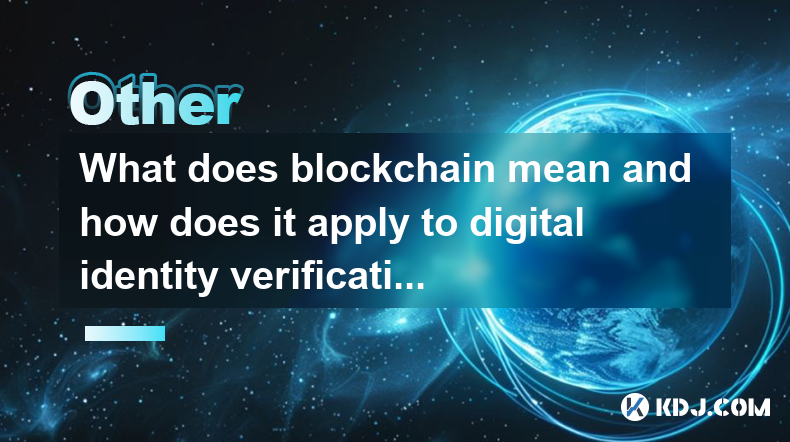
What does blockchain mean and how does it apply to digital identity verification?
Apr 03,2025 at 02:21am
Blockchain technology, at its core, is a decentralized and distributed digital ledger used to record transactions across numerous computers. This ensures that the recorded data cannot be altered retroactively without the alteration of all subsequent blocks and the consensus of the network. The concept of blockchain was initially devised for the digital ...
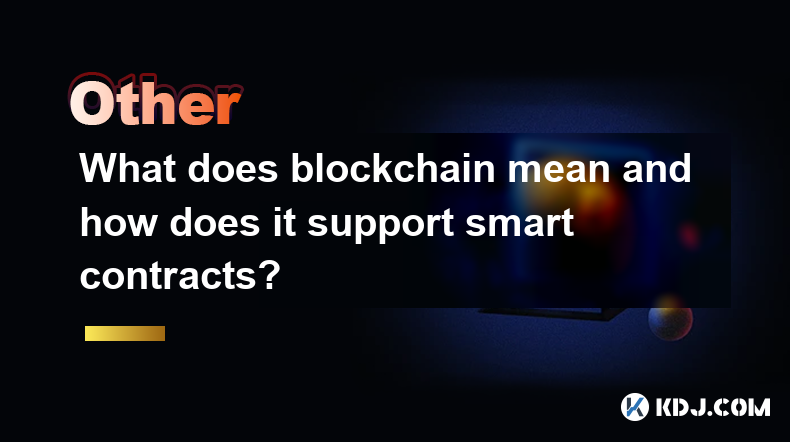
What does blockchain mean and how does it support smart contracts?
Apr 03,2025 at 02:28am
Blockchain technology is a decentralized, distributed ledger that records transactions across numerous computers. It ensures that once data is recorded, it cannot be altered retroactively without the alteration of all subsequent blocks and the consensus of the network. This technology is the backbone of cryptocurrencies like Bitcoin and Ethereum. Blockc...
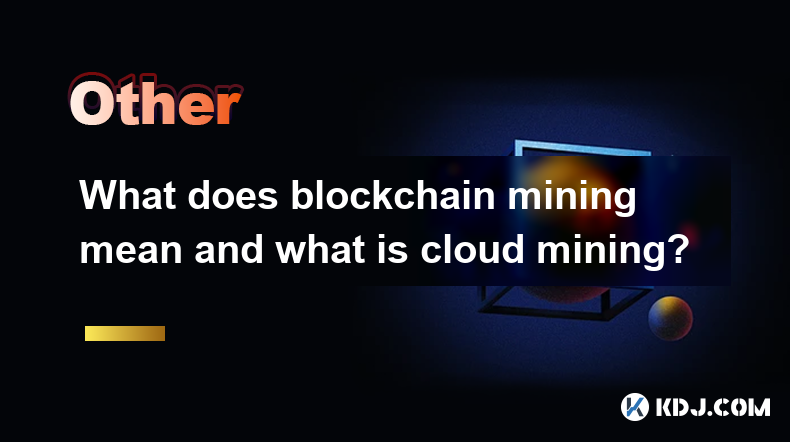
What does blockchain mining mean and what is cloud mining?
Apr 03,2025 at 02:01am
Blockchain mining is the process by which new transactions are verified and added to the blockchain ledger. It involves solving complex mathematical problems using computational power, which results in the creation of new cryptocurrency units as a reward. Miners compete to solve these problems, and the first one to find the solution gets to add a new bl...
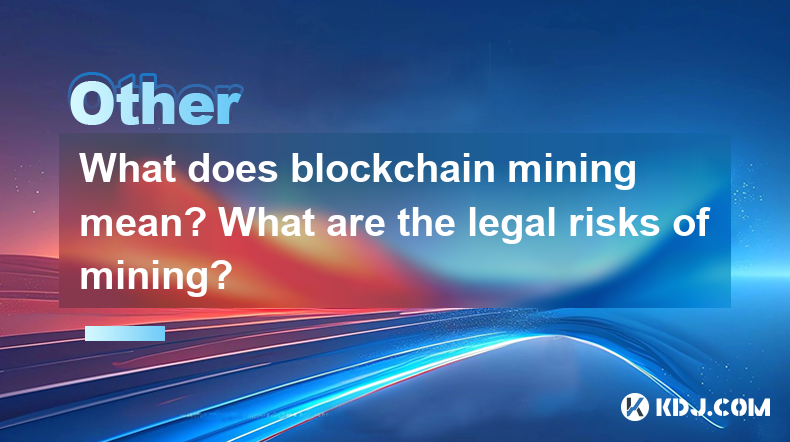
What does blockchain mining mean? What are the legal risks of mining?
Mar 31,2025 at 05:07pm
Blockchain mining is the process by which transactions are verified and added to the public ledger, known as the blockchain. Miners use powerful computers to solve complex mathematical problems, which, once solved, allow them to add a block of transactions to the blockchain. In return, miners are rewarded with cryptocurrency, typically Bitcoin. This pro...
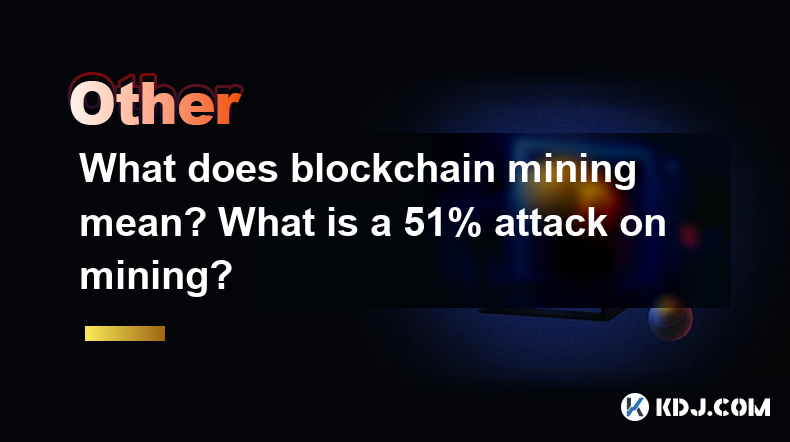
What does blockchain mining mean? What is a 51% attack on mining?
Apr 02,2025 at 03:28am
Blockchain mining is a critical process in the world of cryptocurrencies, particularly those that use proof-of-work (PoW) consensus mechanisms like Bitcoin. Mining involves using computational power to solve complex mathematical puzzles, which, when solved, validate and add new transactions to the blockchain. Miners are incentivized to participate throu...
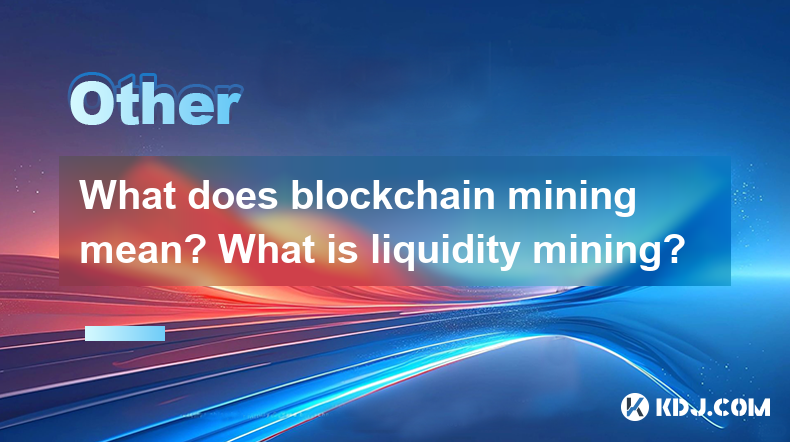
What does blockchain mining mean? What is liquidity mining?
Apr 01,2025 at 12:07am
What is Blockchain Mining?Blockchain mining is a critical process in the world of cryptocurrencies, particularly for networks like Bitcoin and Ethereum. It involves the use of computational power to solve complex mathematical problems, which in turn validates transactions and adds them to the blockchain. Miners are incentivized through rewards, typicall...

What does blockchain mean and how does it apply to digital identity verification?
Apr 03,2025 at 02:21am
Blockchain technology, at its core, is a decentralized and distributed digital ledger used to record transactions across numerous computers. This ensures that the recorded data cannot be altered retroactively without the alteration of all subsequent blocks and the consensus of the network. The concept of blockchain was initially devised for the digital ...

What does blockchain mean and how does it support smart contracts?
Apr 03,2025 at 02:28am
Blockchain technology is a decentralized, distributed ledger that records transactions across numerous computers. It ensures that once data is recorded, it cannot be altered retroactively without the alteration of all subsequent blocks and the consensus of the network. This technology is the backbone of cryptocurrencies like Bitcoin and Ethereum. Blockc...

What does blockchain mining mean and what is cloud mining?
Apr 03,2025 at 02:01am
Blockchain mining is the process by which new transactions are verified and added to the blockchain ledger. It involves solving complex mathematical problems using computational power, which results in the creation of new cryptocurrency units as a reward. Miners compete to solve these problems, and the first one to find the solution gets to add a new bl...

What does blockchain mining mean? What are the legal risks of mining?
Mar 31,2025 at 05:07pm
Blockchain mining is the process by which transactions are verified and added to the public ledger, known as the blockchain. Miners use powerful computers to solve complex mathematical problems, which, once solved, allow them to add a block of transactions to the blockchain. In return, miners are rewarded with cryptocurrency, typically Bitcoin. This pro...

What does blockchain mining mean? What is a 51% attack on mining?
Apr 02,2025 at 03:28am
Blockchain mining is a critical process in the world of cryptocurrencies, particularly those that use proof-of-work (PoW) consensus mechanisms like Bitcoin. Mining involves using computational power to solve complex mathematical puzzles, which, when solved, validate and add new transactions to the blockchain. Miners are incentivized to participate throu...

What does blockchain mining mean? What is liquidity mining?
Apr 01,2025 at 12:07am
What is Blockchain Mining?Blockchain mining is a critical process in the world of cryptocurrencies, particularly for networks like Bitcoin and Ethereum. It involves the use of computational power to solve complex mathematical problems, which in turn validates transactions and adds them to the blockchain. Miners are incentivized through rewards, typicall...
See all articles
























































































